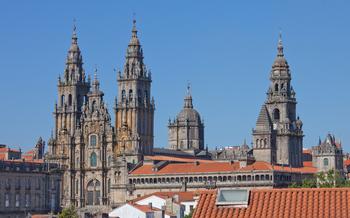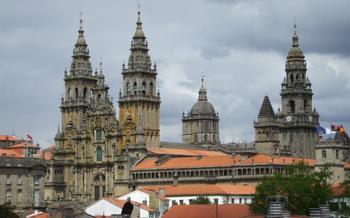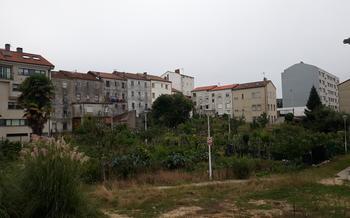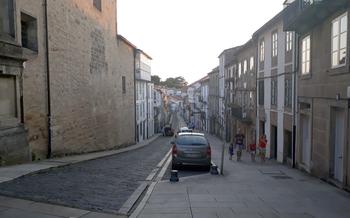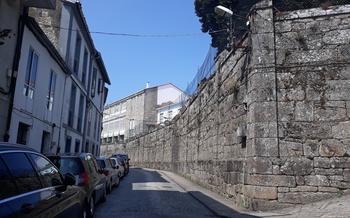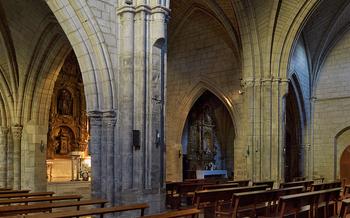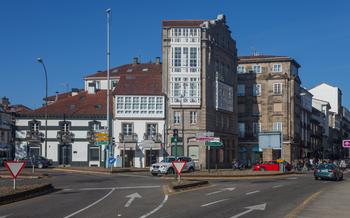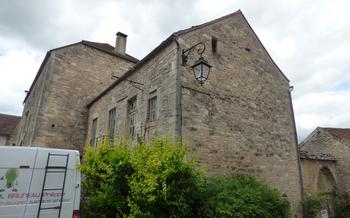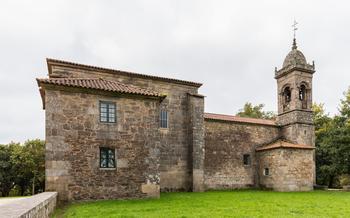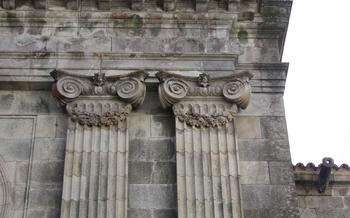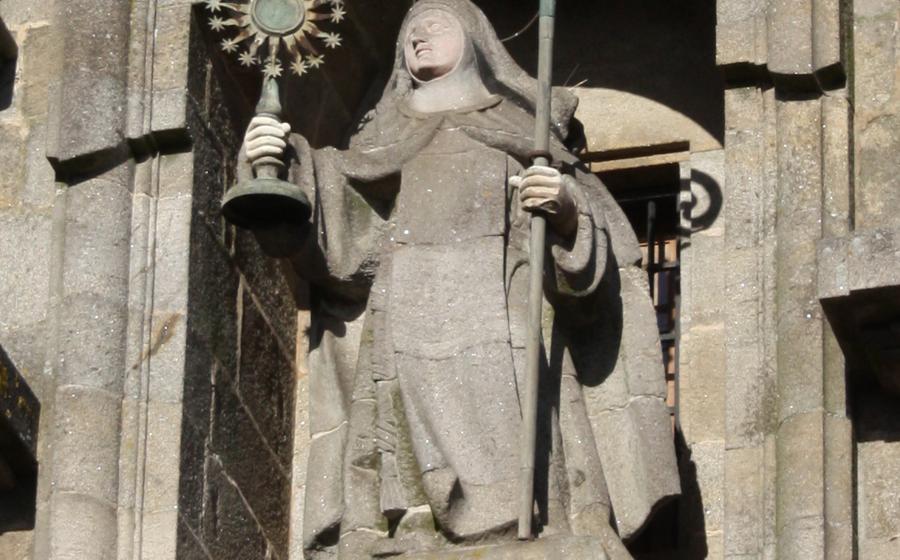
Convent and Church of Santa Clara
- History and Significance
- Architectural Marvel
- Interior Splendor
- Altarpiece Masterpiece
- Royal Pantheon
- Cloister Serenity
- Museum Treasures
- Guided Tours
- Pilgrimage Significance
- Local Traditions
- Dress Code and Etiquette
- Photography and Videography:
- Accessibility:
- Hours of Operation and Admission:
- Insider Tip:
History and Significance
Founded in the early 13th century, the Convent and Church of Santa Clara is a testament to the enduring legacy of the Poor Clares, a branch of the Franciscan order. The Poor Clares, devoted to a life of poverty and austerity, sought to emulate the life of Saint Clare of Assisi, their founder. The convent became a spiritual and cultural center in Santiago de Compostela, attracting devout women from noble families who sought a life of seclusion and religious devotion. Its strategic location along the Camino de Santiago further contributed to its significance, as pilgrims found solace and spiritual guidance within its walls. Over the centuries, the convent has undergone several renovations and expansions, reflecting the changing needs of its community and the evolving architectural styles of the era.
Architectural Marvel
The Convent and Church of Santa Clara stands as a testament to the harmonious blend of Gothic and Renaissance architectural styles. Its Gothic roots are evident in the pointed arches, ribbed vaults, and flying buttresses that lend a sense of grandeur to the structure. The church's interior features a nave and side aisles, separated by elegant columns that support the intricate vaulted ceiling. Renaissance influences are seen in the decorative details, such as the ornate carvings, medallions, and friezes that adorn the walls and portals. The harmonious fusion of these two architectural styles creates a visually stunning edifice that captivates visitors with its intricate beauty and timeless appeal.
Interior Splendor
The interior of the Church of Santa Clara is a testament to the artistry and devotion of its creators. As you step inside, your eyes are immediately drawn to the nave, which is flanked by elegant side aisles. The soaring Gothic arches create a sense of awe and grandeur, while the ribbed vaults add a touch of lightness and grace.
The intricate stained glass windows, depicting biblical scenes and saints, cast a colorful glow upon the interior, creating an ethereal atmosphere. The intricate details and vivid colors of the windows are a testament to the skill of the artisans who created them.
The walls and ceilings of the church are adorned with beautiful frescoes and paintings, which further enhance its beauty and sacredness. These artworks depict scenes from the life of Jesus and the Virgin Mary, as well as stories from the Bible. The vibrant colors and lifelike figures bring the stories to life, creating a sense of connection between the viewer and the divine.
Altarpiece Masterpiece
The Convent and Church of Santa Clara houses a stunning altarpiece, widely considered a masterpiece of Gothic art. Crafted in the 15th century, the altarpiece is a testament to the skill and devotion of the artisans who created it. Intricate carvings depict scenes from the life of Jesus and the Virgin Mary, with intricate details that bring the biblical stories to life. The use of polychrome and gold leaf adds to the grandeur of the altarpiece, creating a sense of awe and reverence. The altarpiece serves as a focal point within the church, drawing the eyes of visitors and inspiring a sense of wonder and contemplation.
Royal Pantheon
Within the sacred walls of the Convent of Santa Clara lies a place of eternal rest for Spanish royalty—the Royal Pantheon. This hallowed chamber serves as the final resting place for several kings and queens who have left an indelible mark on the nation's history. Elaborate tombs adorned with intricate carvings and effigies stand as silent witnesses to their reign and the passage of time.
The Royal Pantheon exudes an aura of solemnity and grandeur, paying homage to the monarchs who once ruled over Spain. Visitors can wander through this serene space, marveling at the artistry and craftsmanship that adorn the tombs, each one a testament to the life and legacy of the deceased sovereign.
Among the notable figures interred in the Royal Pantheon are Isabella I of Castile and Ferdinand II of Aragon, the Catholic Monarchs who united Spain and ushered in a golden age of exploration and cultural flourishing. Their imposing tomb, a masterpiece of Gothic architecture, features intricate carvings depicting scenes from their lives and reign.
The Royal Pantheon stands as a testament to the deep connection between the Convent of Santa Clara and the Spanish monarchy. It is a place where history and spirituality intertwine, inviting visitors to reflect on the lives and legacies of those who have shaped the nation's destiny.
Cloister Serenity
Step into the serene embrace of the cloister, a tranquil oasis within the bustling city. Gothic arches, intricately carved in stone, frame the perimeter, creating a sense of seclusion and tranquility. The central garden, a verdant haven, bursts with vibrant greenery, its aromatic blooms filling the air with a sweet fragrance. Originally designed as a place for meditation and contemplation, the cloister invites visitors to slow down, find solace, and connect with their inner selves. As you wander beneath the graceful arches, the stresses of the outside world melt away, replaced by a sense of peace and tranquility.
Museum Treasures
Within the sacred walls of the Convent of Santa Clara lies a treasure trove of religious and historical artifacts, carefully preserved and exhibited in a museum open to the public. Step inside and embark on a journey through time as you encounter a diverse collection of relics, manuscripts, and artwork that tell the story of this remarkable institution.
Among the notable exhibits, you'll find sacred relics that hold deep spiritual significance, such as fragments of the True Cross and relics of saints venerated throughout the centuries. These relics serve as tangible reminders of the faith and devotion that have permeated these halls for generations.
The museum also boasts a collection of ancient manuscripts, some of which date back to the Middle Ages. These precious documents offer a glimpse into the intellectual and spiritual life of the Poor Clares nuns, shedding light on their daily practices, beliefs, and contributions to scholarship.
In addition to these sacred artifacts, the museum showcases a variety of artwork, including paintings, sculptures, and tapestries that adorn the convent's walls and altars. These artistic masterpieces reflect the talent and devotion of skilled artisans who dedicated their craft to beautifying the house of God.
The museum at the Convent of Santa Clara stands as a testament to the rich history and enduring legacy of this sacred site. It invites visitors to delve deeper into the stories and traditions that have shaped this institution, offering a glimpse into the spiritual and cultural heritage of Santiago de Compostela.
Guided Tours
To fully appreciate the rich history, architecture, and significance of the Convent and Church of Santa Clara, consider taking a guided tour. Knowledgeable guides can provide insights into the convent's founding, its role in the Poor Clares order, and its connection to the Camino de Santiago. They can also explain the symbolism and stories behind the intricate carvings, stained glass windows, and other works of art.
Guided tours are available in various languages and offer a more personalized and interactive experience. Visitors can ask questions, gain a deeper understanding of the convent's history and significance, and appreciate the many details that might otherwise go unnoticed. Both group tours and private tours are available, allowing visitors to choose the option that best suits their preferences and budget.
Pilgrimage Significance
The Convent and Church of Santa Clara holds immense significance for pilgrims undertaking the iconic Camino de Santiago, a network of ancient pilgrimage routes leading to the Cathedral of Santiago de Compostela. For centuries, weary pilgrims have found solace and spiritual renewal within the convent's sacred walls.
The convent serves as a welcome resting place for pilgrims, offering a haven of peace and tranquility amidst their arduous journey. Pilgrims are warmly welcomed by the nuns, who provide them with food, shelter, and spiritual guidance. The convent's serene atmosphere and the opportunity to receive a blessing from the nuns create a profound sense of connection and renewal for pilgrims.
Moreover, the convent's location along the Camino makes it a natural stopping point for pilgrims seeking spiritual sustenance and encouragement. The nuns' presence and their commitment to providing hospitality to pilgrims exemplify the spirit of the Camino, which is characterized by camaraderie, generosity, and a shared sense of purpose.
Local Traditions
The Convent and Church of Santa Clara is deeply intertwined with the local traditions and customs of Santiago de Compostela. Each year, the convent hosts the Feast of Santa Clara, a vibrant celebration honoring the convent's patron saint. During this festival, the convent opens its doors to the public, offering guided tours, special masses, and traditional music performances. Pilgrims and locals alike gather to pay homage to Santa Clara and seek her blessings. The convent also plays a vital role in the community by providing spiritual guidance, education, and social services to the people of Santiago de Compostela. Its presence has shaped the cultural fabric of the city, making it a beloved and respected institution among the locals.
Dress Code and Etiquette
When visiting the Convent and Church of Santa Clara, it is essential to observe proper dress code and etiquette to show respect for the religious nature of the site. Visitors are expected to dress modestly and appropriately, avoiding revealing or overly casual clothing. Shoulders and knees should be covered, and low-cut tops, shorts, and tank tops are discouraged. It is also important to be mindful of noise levels and maintain a reverent atmosphere within the church and cloister. Photography and videography are permitted in designated areas, but visitors should refrain from using flash or disturbing others during religious services or ceremonies. By adhering to these guidelines, visitors can contribute to the preservation and tranquility of this sacred space.
Photography and Videography:
Photography and videography are generally permitted within the Convent and Church of Santa Clara, but visitors are kindly requested to be respectful and mindful of the sacred nature of the site. Flash photography and tripods are not allowed inside the church to preserve the artworks and maintain a peaceful atmosphere. Visitors are encouraged to capture the beauty of the convent and its surroundings with their cameras, but it is important to avoid disturbing other visitors or disrupting any religious services or ceremonies that may be taking place. When taking photographs or videos, visitors should be mindful of their surroundings and avoid capturing images of people without their consent. It is always advisable to ask for permission before photographing or filming individuals, especially within the cloister or other private areas of the convent.
Accessibility:
The Convent and Church of Santa Clara is committed to providing an accessible and inclusive environment for visitors with disabilities. Wheelchair ramps and elevators are available to ensure that all areas of the site are accessible. Visitors with disabilities are encouraged to contact the convent in advance to arrange for any specific accommodations or assistance they may require. While the majority of the convent is wheelchair accessible, there may be certain areas, such as the bell tower or the cloister's upper level, that may present challenges. The friendly and helpful staff at the convent is always ready to assist visitors with disabilities and provide alternative options to ensure a fulfilling and enjoyable experience for all.
Hours of Operation and Admission:
The Convent and Church of Santa Clara welcomes visitors throughout the year, offering a rich and rewarding experience. It is generally open to the public from 9:30 am to 1:00 pm and from 4:00 pm to 6:30 pm, allowing ample time to explore its many wonders. However, it is advisable to check the official website or contact the convent directly for any seasonal variations or special closures.
Admission to the convent and church is free of charge, allowing all visitors to immerse themselves in its history and beauty without financial barriers. This generous policy ensures that everyone has the opportunity to appreciate the spiritual and cultural significance of this sacred site.
To make the most of your visit, plan your trip during the off-season or on weekdays to avoid the larger crowds that may gather during peak tourist periods. This will allow you to fully absorb the convent's serene atmosphere and take your time exploring its many treasures.
Whether you are a pilgrim seeking spiritual solace or a traveler eager to delve into history and art, the Convent and Church of Santa Clara offers an enriching experience that will leave a lasting impression.
Insider Tip:
For an unforgettable experience, plan your visit to the Convent and Church of Santa Clara during the annual Feast of Santa Clara, held on August 12th. This vibrant festival transforms the convent's surroundings with colorful processions, traditional music, and lively dancing. Immerse yourself in the local culture as you witness the devotion of pilgrims and residents alike, celebrating the life and legacy of Saint Clare. Don't miss the opportunity to partake in the festivities and join the joyful atmosphere that engulfs the convent during this special time.
